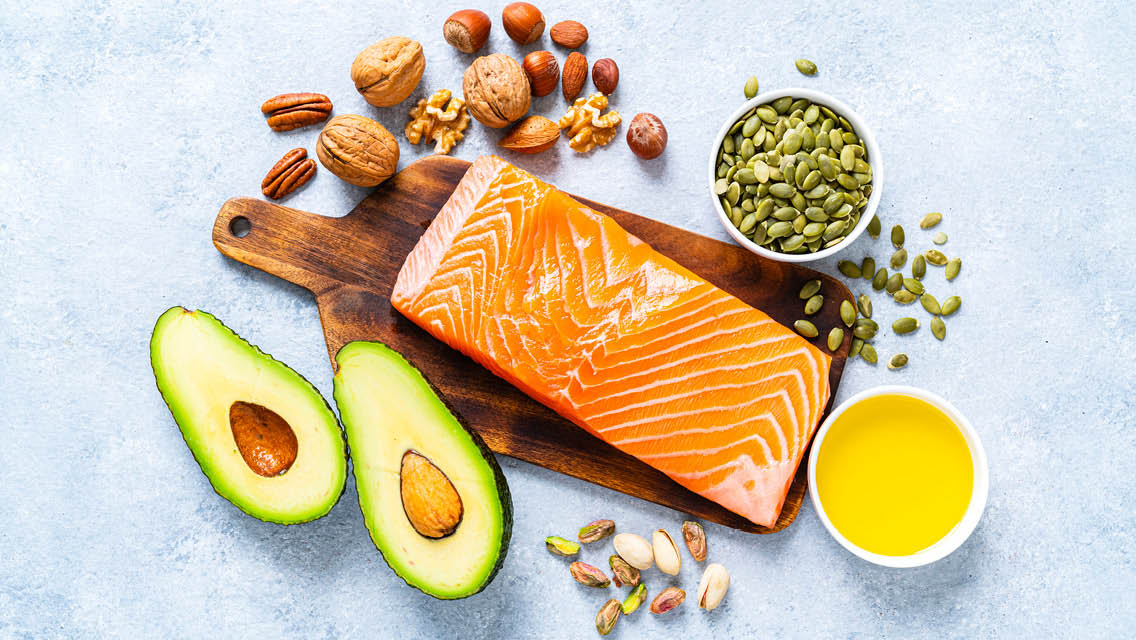Non-fat. Reduced fat. Low fat. Less fat. Evidence of our fat phobia has stormed supermarket shelves, and we are, quite literally, eating it up. Why, then, are we not getting thinner?
In the 1990s, U.S. sales of low-fat foods nearly tripled. In that same time period, the percentage of obese Americans increased by over 5 percent. Recent studies now report that more than half of the nation’s adults (and nearly as many of our children) are clinically overweight.
According to scientist, scholar and author Udo Erasmus, who holds an M.A. in psychology and a Ph.D. in nutrition, our very fear of fat may be largely to blame. The solution, he says, lies not in avoiding all dietary fats (as many of us have been led to believe) but in getting ample amounts of healthy fats while eliminating the unhealthy ones.
Erasmus, author of Fats That Heal, Fats That Kill, pioneered the popular study of omega-3 and omega-6 essential fatty acids (EFAs) after he was poisoned by carcinogenic pesticides at work in 1980. He dove into several years of intensive research in an effort to save his own life, and emerged with information that turned heads in the scientific community.
Not only did EFAs show links to longevity, energy level, fat loss and athletic performance, there were also strong suggestions that they played a role in the prevention and reversal of everything from cancer and heart disease to arthritis and addiction. Erasmus’s book, a veritable encyclopedia on the impacts of dietary fat, is now in its 11th printing.
Must-Have Fats
“EFAs are intimately involved in the formation and function of every cell and every tissue in the human body,” says Erasmus. They are at least as critical as vitamin C, he insists, and yet most Americans have virtually no understanding of EFAs’ nutritional importance. If they did, he says, “There would be a jar of EFA oil in every fridge, preferably in front of the milk and bread.”
Why? For one thing, EFAs help, rather than hinder, the body’s metabolic function and significantly aid in weight loss. Rather than becoming mere energetic fuel you must burn off, they help to build your fuel-burning metabolic machinery. So eating these fats can actually help you become leaner? Correct. And establishing a proper ratio and intake of EFAs will reap you other major benefits as well, including increased athletic performance and better mood and brain function.
The other thing is, including adequate amounts of fat in your diet helps satisfy both your appetite and your palette. When you are eating enough fats, you tend to crave fewer starches and sugars, so it is easier to reduce your overall calorie intake without feeling deprived. Your blood sugar and energy levels also remain more consistent.
Remember though, not all fats are created equal. Many of today’s trendy, high-fat, low-carb diets fail to differentiate between good and bad fats, and their emphasis on large quantities of dairy and flesh foods could cause people to overdose on unhealthy saturated fats while still leaving them deficient in EFAs.
EFAs Defined
The E in EFA is there for a reason. It stands for “essential,” and that means that your body cannot function without it. Go without adequate EFAs for a while, and your health, energy and appearance will suffer. Go without them for long enough, and your organ and immune function will shut down. And then, in short order, you will die.
The fact is, your body cannot produce EFAs on its own. And because EFAs are necessary for triggering some very vital biochemical reactions, you must ingest the right amount and right ratios of these good fats in order for those reactions to occur and for your good health to continue.
There are three main EFA substances that work together to promote health. The first is omega-3 fatty acid, or alpha-linolenic acid. The second is omega-6 fatty acid, or linolenic acid. Take these in the right ratios (2 to 1, respectively) and they help the body produce a whole host of equally important derivatives (including omega-9 fatty acids). The third is actually a group of substances – including lecithin, carotene, chlorophyll and vitamin E, among others — known as “minor ingredients.” Present in tiny concentrations in unprocessed oils (and absent in processed ones), they’re of major importance because they provide significant health benefits.
Okay, so how do you get these almighty EFAs? Whole foods are the ticket. The closer a food is to its natural state, without additives or processing, the better. Look to cold-water fish, nuts and seeds, leafy greens and organic, natural health oils as primary sources of good fat. Most Americans should also consider an EFA supplement — one that supplies a proper blend of omega-3s and omega-6s — in either a liquid oil or capsule form. Erasmus suggests one tablespoon of oil per 50 lb. of body weight per day, so if you are taking yours in capsules, just be aware it may mean taking quite a few of them.
More Fat, Please
Ironically, the reason we Americans originally went gaga for reduced-fat foods – our desire to lose weight – is precisely the same reason we should be avoiding them now. Here’s how it works: When you don’t get enough dietary fat, your body (which requires a certain amount of fat to function) goes to work overtime manufacturing fat for you – typically out of carbohydrates. Your body sends out a carbo craving. You eat a bunch of low-fat carbs to oblige and, whammo, you wind up fatter than if you’d gulped the same number of calories as straight oil. Now if you’d opted to ingest those calories as EFA-rich healthy fats instead, you’d be ahead of the game. “EFAs turn down the genes that produce fat and turn up those that burn it,” Erasmus explains. “By upping good fats and lowering simple carbohydrates, you can actually burn more calories even while sitting on your duff.”
So, for weight-watchers, here’s the bottom line: Forget your calorie fixation, and start up a new health fixation instead. Don’t go crazy avoiding carbs, just get more of your carbs from greens and other brightly colored veggies.
Most importantly, lose your low-fat mania. Once you up your healthy-fat intake, you can expect your carb and/or sugar cravings to subside dramatically. Ensure adequate EFA consumption along with the usual recommended vitamins, minerals, proteins and fiber, and you’ll be well on your way to a superb physique.
Are You EFA-Deficient?
When your body lacks something, it lets you know. Dry, flaky skin, low energy and joint pain are just some of the early signals your body may send to say it could use more EFAs. Try this test: Run your fingernail across a patch of skin. It should not leave a mark. If you see a white line or dry flakes, it’s time to seek out more EFAs. When your skin looks and feels velvety smooth, you’ll know you’re on the right track.
Fats That Heal, Fats That Kill
Most of us could use more of these:
- Cold processed, organic oils derived from flaxseed, sunflower, safflower, hemp, sesame, evening primrose and olive (look for dark bottles and store them in the fridge; also be sure to read the labels and get those omega-3 and omega-6s in proper 2-to-1 ratios).
- Dark, leafy greens (spinach, kale, chard, arugula).
- Fats found in raw fruits, vegetables or nuts (including raw nut butters, avocados, etc.).
- Cold-water fish (uncooked or very lightly cooked is best).
And less of these:
- Animal fats, tropical oils (palm, coconut, etc.), dairy and other saturated fats.
- Unrefridgerated supermarket oils that come in clear bottles or plastic jugs (most cold-pressed organic oils are okay; olive oil is usually your best bet for cooking).
- Trans-fatty acids (present in hydrogenated or partially hydrogenated oils, many prepared, fast and packaged foods, fried foods, most margarines).
- Sautéed and grilled meats (steaming or baking is better for you — bummer, huh?)
Brain Food
Did you know that the human brain is something like 60 percent fat? Totally true. It’s also true that depriving your body of EFAs can seriously upset your brain chemistry, impacting memory and intellectual function. A variety of mental, behavioral and emotional disorders — including depression, bi-polar and attention-deficit disorders — have been linked to EFA depletion.
Optimal Athletic Performance
In a recent study conducted in Denmark, Erasmus’s research team gave professional athletes a carefully balanced, organic EFA oil blend — a tablespoon daily for every 50 lb. of bodyweight. Over the course of a month, the cyclists, on average, went 35 miles farther a day. The runners added 37 miles to their weekly total mileage. And body builders and weight lifters with knee pain reported considerable relief.
A stamina booster with possible anti-inflammatory properties? Not a bad nutritional bargain. EFAs also work to balance prostaglandins (cellular messengers) and to regulate hormonal and insulin function, all of which support metabolic function, help your muscles eliminate lactic acid and help your entire body to recover after intense workouts.
To learn more about Udo Erasmus and his work with healthy fats, visit www.udoerasmus.com or call 1-800-446-2110.
This originally appeared in Experience Life magazine as “Essential Fatty Acids.”
This article has been updated. It originally appeared online on November 1, 2001.




This Post Has 0 Comments